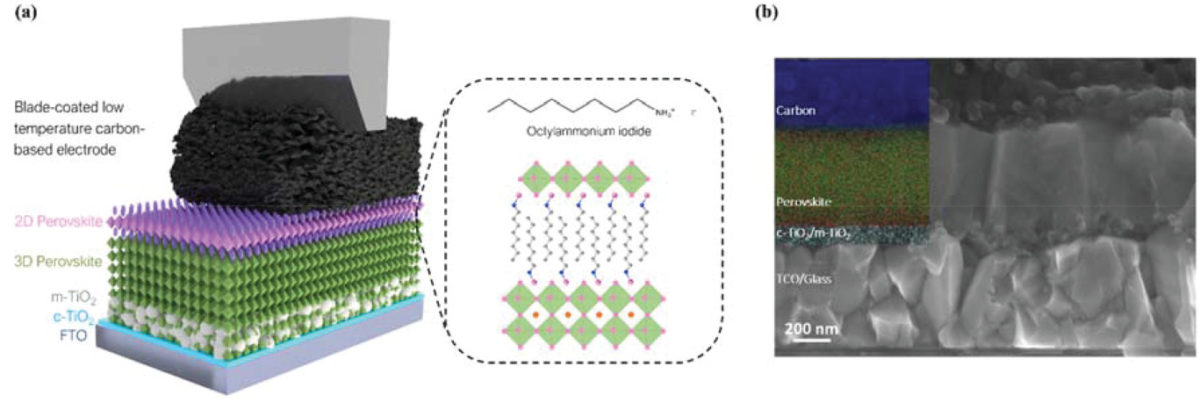It is generally accepted today that, at some point in the not-too-distant future, perovskite solar cells will make their way into mass production and allow for solar energy yields far beyond those of today’s technology. But, as to the specific materials and device structure(s) that will make it beyond the research stage, there are still many different routes being pursued, each with its own disadvantages and disadvantages.
Creating contacts for the cell, which allow the generated current to flow out of it, offers one example.
“Metal contact electrodes [commonly used today] can stimulate degradation of PSCs due to diffusion of metal impurities across the interfaces,” said scientists led by Fraunhofer ISE in a newly published paper. “This problem can be fundamentally overcome by replacing the metal contact with chemically inert and robust carbon-graphite electrodes in PSCs (C-PSCs), which are highly promising for commercialization due to their ambient pressure processability based on industrially established printing techniques.”
They go on to explain that C-PSCs create a problem elsewhere in the cell, leading to performance losses at the point where the carbon electrode meets the perovskite layer. And to overcome this, Fraunhofer Institute for Solar Energy Systems ISE worked with scientists at École polytechnique fédérale de Lausanne (EPFL) in Switzerland to develop a blocking layer to place between the two.
They deposited another perovskite formulation onto the active cell layer, and using various imaging techniques, they were able to confirm that this additional layer served to block electrons from movement in the “wrong” direction, and increase the cell performance.
Thy described the approach in “Employing 2D-Perovskite as an Electron Blocking Layer in Highly Efficient (18.5%) Perovskite Solar Cells with Printable Low Temperature Carbon Electrode,” which was recently published in Advanced Energy Materials. As the title suggests, the group fabricated cells that reached 18.5% efficiency and maintained 82% of this after 500 hours of constant, one-sun illumination. A control device fabricated without the blocking layer achieved 15.7% initial efficiency, and had lost 63% of this after 200 hours under illumination.
“We believe that the approach of the employment of 2D perovskite as an EBL can help pave the way for the future practical development of fully printable C-PSCs with high efficiency and long-term stability,” the group concluded.
This content is protected by copyright and may not be reused. If you want to cooperate with us and would like to reuse some of our content, please contact: editors@pv-magazine.com.




4 comments
By submitting this form you agree to pv magazine using your data for the purposes of publishing your comment.
Your personal data will only be disclosed or otherwise transmitted to third parties for the purposes of spam filtering or if this is necessary for technical maintenance of the website. Any other transfer to third parties will not take place unless this is justified on the basis of applicable data protection regulations or if pv magazine is legally obliged to do so.
You may revoke this consent at any time with effect for the future, in which case your personal data will be deleted immediately. Otherwise, your data will be deleted if pv magazine has processed your request or the purpose of data storage is fulfilled.
Further information on data privacy can be found in our Data Protection Policy.